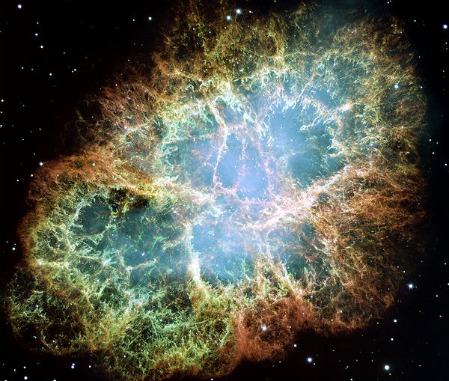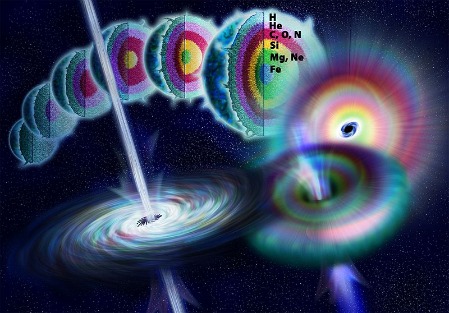On July 2, 1967 two top secret US survelliance satellites, Velas 3 and 4, spied an alarming phenomenon. The Vela sats were designed to detect the telltale radiation of nuclear tests by the USSR. But on that day these two picked up a flash of gamma rays from the other direction, not here on earth, but rather out in space. Soon more flashes were seen, astrophysicists were called in, sworn to secrecy, and allowed to examine the data. They determined these gamma flashes weren’t commie nuke tests in space, the flashes lasted too long and faded too slowly, this was something else, something new. And as the data accumulated scientists realized they were witnessing the brightest, most energetic events since the Big Bang. Gamma Ray Bursts, referred to as GRBs, burst onto the cosmic scene like an atomic bomb, pardon the pun, and a new field of astronomy was born. Last year that field found itself looking at one of the most mysterious GRB’s ever seen
(Link) The Christmas burst, also known as GRB 101225A, was discovered in the constellation Andromeda by Swift’s Burst Alert Telescope at 1:38 pm EST on Dec. 25, 2010. Follow-up observations by the Hubble Space Telescope and ground-based observatories failed to determine its distance.
The gamma-ray emission lasted at least 28 minutes, which is unusually long.
Today its been pretty well worked out that hypernovas explain many GRBs. Massive stars that rip through their nuclear fuel in as little as a million years and blow to smithereens, salting the cosmos with everything from oxygen to gold and leaving behind a tiny, unimaginably dense core that collapses into a black hole. The electro-magnetic field produced in such an event is of incomprehensible power, so strong it would rip the iron molecules right out of your blood and bones in a gory streamer. In the immediate aftermath of a hypernova, those same magnetic effects concentrate and fire out jets of gamma rays like some kind of super weapon, if we happen to lay in that path and have our hi energy eyes wide open, we can detect them even from billions of light-years away. If somehting like this were to go off anywhere in our stellar neighborhood and we happened to lay in the path of one of the two jets, the effect on our world would be crossing-the-plasma-streams Ghostbusters bad.
But the Christmas 2010 GRB was particularly long lasting and scientists have been analyzing it ever since. Some feel the hypernova model works just fine here too. But two alternative and fascinating explanations have been putforth this week: the Christmas GRB was produced by a comet or asteroid hitting a neutron star, or a collision between a red giant and a neutron star.
Neutron stars are failed black holes. They’re also the core left behind by massive stars, the mass of a sun shrunk down to the size of a city and spinning wildly thanks to the conservation of angular momentum. Think of an ice skater pulling her two-thousand mile long arms in while spinning and you get the idea. Neutron stars have a magnetic field which spins with them, one we can detect and measure as pulses per second so perfectly regular that when they were first detected there was speculation of little green men. Young pulsars are usually turning fast, and there’s plenty of debris around given their violent origin making pulsar nebula some of the most exquisite objects in the night sky.

The Crab Nebula, produced by a supernova 1000 years ago, relative time, and energized by a tiny, spinning neutron star deep inside, as seen by Hubble
Pulsars are incredibly useful to cosmology. For one thing they sometimes come in pairs, ancient binary systems where both members become neutron stars, and because of their massive surface gravity nearby objects are hauling ass, apporaching significant fractions of the speed of light. We can measure the changes in rotation by observing the rate they’re spinning at and viola, we have the perfect, highly accurate super clock in position to actually observe and transmit some esoteric consequences of general and special relativity.
Exosolar astronomers have even found evidence for planets orbiting neutron stars. Why not? Nearby planets wouldn’t survive the initial explosion, but there’s plenty of gas and dust in their vicinity afterward to form new dust grains which could grow into comets and asteroids and accrete into planets. Now think what would happen if a chunk of protoplanet were to spiral into the neutron star. These things have enormous surface gravity, thousands of times stronger the surface gravity of earth. An object the size of pea would be acelerated so much that by the time it hit the exotic surface it would light up bigger than the biggest H-bomb ever detonated on earth. A small comet or asteroid just a few meters in diameter would be shredded like Shoemakey-Levy 9, spaghettified into a streamer of debris that could smash into the surface over a period of several minutes. The resulting gamma ray signature could explain the Christmas 2010 event and an entire class of long lasting GRBs.
As violent as that would be, the second suggestion is a truly cosmic event. In that scenario a pulsar forms near a star undergoing expansion into a red giant. As the surface of the giant star expands the thin, ghostly outer enevelope eventually swallows the orbit of the tiny, dense companion. The neutron star’s orbit decays until it falls toward the denser starry mantle below like a meteor streaking through terrestrial skies. But a twenty mile wide ball of neutronium doesn’t stop when it enters those denser, lower layers. It punches through them like a bullet through fog until it rips into the very core of the red giant. The only posisble outcome of that hellish marriage would be a black hole suddenly sitting at the center of the giant star, which could also explain the unusual duration of the Christmas gamma ray burst.
Whichever idea is correct, the 2010 GRB was one hell of a Christmas present for stellar astronomers (An astronomer friend of mine left her Christmas day feast and rushed back to her office to work on it, and amost got in an accident, giving rise to our pet joke, Grandma got runover by a GRB). And if anything like it happens again this year, why we just might have to recoginze it as a true Christmas miracle!


The Vela sats were designed to detect the telltale radiation of nucular tests by the USSR.
Is that you, Dubya?
Heheheh. I actually fixed that but it may take a few minutes to show up. Spell check is not working for the blog right now. Yet another gift from an Internet full of such gifts which needlessly wastes everyone’s time.
Skeptic or not, I can’t help but find some meaning in this incredibly violent event occurring just 4 days (or thereabouts) after my friend Nicole suddenly died last year. How absurd it is to think of an event so far away having relevance to a meaningless tragedy on Earth; how doubly absurd to connect the two even though it was several days later (surely countless events of import happened throughout the world, let alone the universe in those several days). And yet I read this, and I still think: The Gamma Ray Burst that happened as Nicole was dying.
Sorry to be a downer!
Awesome!
I work as a tour guide at the MAGIC telescope (http://en.wikipedia.org/wiki/MAGIC_(telescope)) so I regularly explain hypernovas, but I was under the impression that most of them last three minutes, ops. (Which is why the MAGIC has to be able to slew quickly, in spite of its enormous size.) 28 minutes is a very, very long GRB. How far away was this? That light must have been travelling since long before the Earth formed.
@jamiesweet, I’m really sorry about your friend.
Sheila, from what I’ve read they did not get a distance on it. Only that it came roughly from the direction of Andromeda.